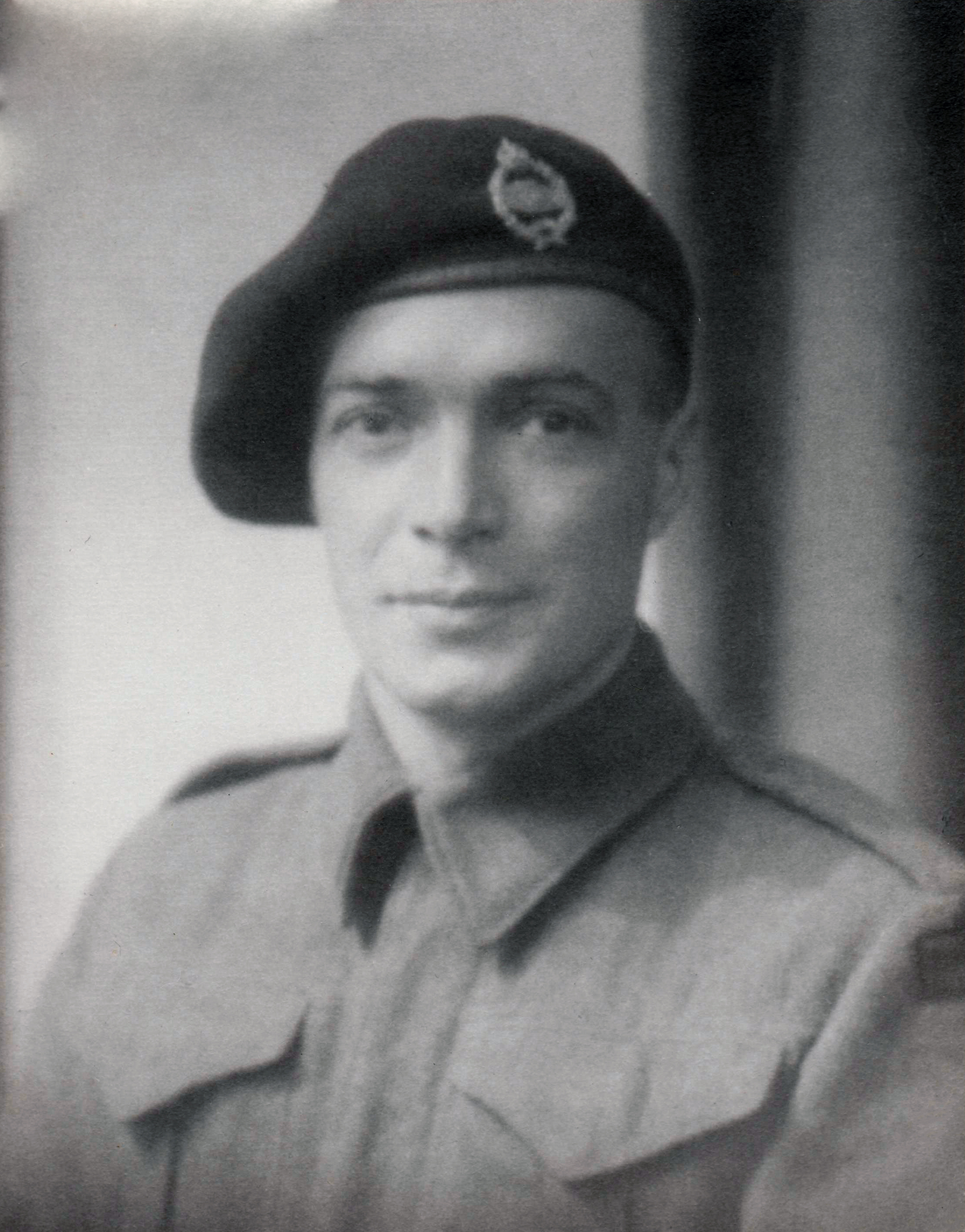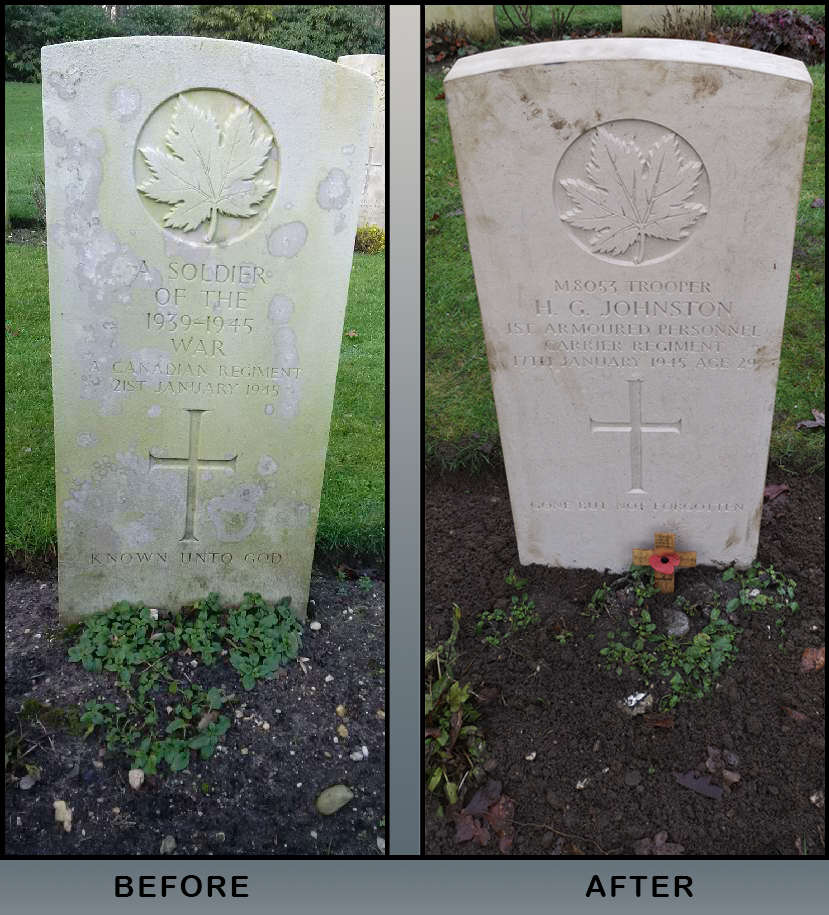Trooper Henry George Johnston
In 2018, a research report was received suggesting that an unknown grave in the Netherlands could be identified. The Canadian Armed Forces confirmed the identity of the grave as that of Trooper Henry George Johnston in November 2019.
Henry George “Archie” Johnston was born on 2 May 1915 in Chauvin, Alberta. He was the son of Mr. Wilbert Johnston and Mrs. Adaline Johnston (née Cyre) of Grimshaw, Alberta. On 30 April 1939, Henry Johnston married Amelia Alice (née Wearden) and together they had five children. Henry’s younger brothers, Edward “Eddie” John Johnston and Wilbert “Bert” Joseph Johnston also enlisted with the Canadian Army, both survived the war.
Prior to enlisting, Johnston worked at a saw mill in Chinook Valley, Alberta. Johnston enlisted in Calgary, Alberta on 29 October 1943 at No. 13 District Depot as a General Reinforcement. After training in Ontario, he embarked for the United Kingdom on 25 June 1944, arriving on 3 July 1944 where he was taken on strength by the No. 3 Canadian Armoured Corps Reinforcement Unit (CACRU), then transferred to 2 CACRU on 7 November 1944. Five days later, Trooper Johnston embarked, arriving in North-West Europe on 12 November where he was taken on strength by the 1st Armoured Personnel Carrier Regiment (1 APCR), Canadian Armoured Corps (CAC), Canadian Active Service Force (CASF).
1 APCR had been formed in Holland on 24 October 1944 out of a desire to transport infantrymen to their objectives more safely. This had followed experiments with several self-propelled guns being converted into infantry carriers in time for Operation TOTALIZE in August 1944 during the Normandy Campaign. 1 APCR used repurposed M7s (known as “Priests”) and Ram Cruiser Tanks that had their guns and turrets removed and instead were outfitted with 0.5 or 0.3 Browning machine guns. A crew consisted of one to two personnel. The regiment quickly earned the nickname of “Kangaroos” since they protected the carried or “empouched” infantry soldiers and moved (or “jumped”) around a lot. The regiment consisted of two squadrons, each with four troops. A squadron had 52 Rams. One Kangaroo Ram could carry 12 infantrymen, so one Kangaroo squadron could transport one infantry battalion safely and quickly to their objective. The Canadian Kangaroos were assigned to the 79th British Armoured Division – a British formation providing specialized equipment in support of all operations. 1 APCR were the only Canadian Regiment to be a part of the British 79th Division.
In January 1945 a renewed Allied effort to clear a pocket of resistance between the Roer and the Maas known as the Roermond Triangle began. As part of the 12th British Corps Operation BLACKCOCK, the 43rd (Wessex) Division advanced with the assistance of 1 APCR. In early January, the units were near Winterslad, Belgium where they prepared to advance to the towns of Roermond and Sittard in the Netherlands, and Heinsberg in Germany. The Operation began on 16 January when 131 Infantry Brigade of the 7th Armoured Division started west of the road running through Susteren and Linne to Roermond with the objective of clearing the villages of German forces. On 16 January, #1 and #2 troops of ‘B’ Squadron, 1 APCR carried British infantry personnel from the Devonshire Regiment. Six Kangaroos carrying members of ‘D’ Company of the Devonshire Regiment broke away from the main column along with a squadron of tanks from the Royal Tank Regiment to stand in Baakhoven in order to offset the threat of heavy counter attacks before rejoining the column the next morning.
During the night of 16/17 January, the six Kangaroos carrying ‘D’ Company at Baakhoven came under heavy shelling. While the men dove under their vehicles for protection, five were injured and Trooper Johnston, a Kangaroo gunner and radio operator, was hit and killed. Witnesses claimed that Trooper Johnston’s remains had been buried though the location was not known. He was officially declared killed in action on 17 January 1945. Following the war, Trooper Johnston was commemorated on Panel 10 of the Groesbeek Memorial as having no known grave.
In January 2018, the Directorate of History and Heritage (DHH) received a research report outlining the possible identification of the grave of an unknown Canadian soldier with the date of death of 21 January 1945 at Plot 3, Row B, Grave 3 of the Commonwealth War Graves Commission’s Mook War Cemetery. The researcher believed that he had successfully identified the grave as belonging to Trooper Johnston of 1 APCR. Though there was a discrepancy with the dates of death, archival evidence was found which proved that the date of death on the original grave marker was incorrect. Documents were also located showing that the grave was originally located near Baakhaven before being concentrated to Mook War Cemetery.
In November 2019, the Casualty Identification Review Board confirmed the identification of Trooper Henry George Johnston of 1 APCR. This was a result of an exhaustive review of archival sources including war diaries, circumstances of casualty register cards, and concentration and exhumation reports. The Casualty Identification Review Board is composed of personnel from DHH, the Commonwealth War Graves Commission, the Canadian Forces Forensic Odontology Response Team, and the Canadian Museum of History.
A headstone rededication ceremony was held on 5 September 2023 at Commonwealth War Graves Commission’s Mook War Cemetery in the Limburg region of the Netherlands. Family members and representatives from the Canadian Armed Forces were in attendance.
For more information on Trooper Johnston, you can consult his personnel file at Library and Archives Canada.
Page details
- Date modified:

